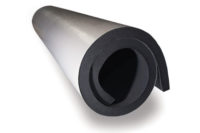Industrial environments present extreme conditions for pipes and vessels that transport, cycle, and store process materials. A broad range of temperatures, volatile materials, and the intermittent cycles that occur during different phases of production all place a burden on process pipes and storage vessels. While insulation is installed to support the thermal performance of processes occurring in these pipes and vessels, careful consideration must always be given to the risk posed by corrosion under insulation (CUI).
Corrosion is defined as the deterioration of a material that occurs from a chemical or electrochemical reaction within its environment. As metal degrades, damage can compromise piping, equipment, and structural steel. When exposed, the extent of corrosion is clearly visible. But because insulation typically covers and thus hides the substrate, corrosive damage may not be noticed until it is extensive and requires a complete replacement.
The cost of an insulating system should be considered in context with its lifespan. Estimates suggest that CUI costs $276 billion or more in the U.S. annually in direct and indirect costs.1 These estimates are supported by anecdotes from industrial facilities staff in the field. Given that corrosion may continue for years without detection, a problem may go undiscovered until a catastrophic event occurs.
Oxygen and liquid moisture are the two common elements that allow corrosion to form on metal substrates and eventually lead to CUI. A hydrocarbon processing facility presents a good example of conditions where corrosion risk must be managed. Chloride ions from salts dissolving in liquid, as well as higher processing temperatures, can create conditions that accelerate corrosion.
Managing CUI risk in all types of industrial environments is key to supporting the longevity of metal piping and equipment. Keeping liquid moisture out of the insulating system and away from the metal substrate is priority one. However, water infiltration is not the only pitfall to avoid when insulating industrial piping. Below, we consider four potential pitfalls to managing CUI risk and look at the material performance of cellular glass in managing them.
Pitfall 1: Neglecting Moisture Management
Defending against CUI involves having a strategy to manage the system’s exposure to moisture. Generally, there are three options to help protect against moisture in the insulating system.
Option one is to change the chemistry of any water that gets into the system. This option aims to make water less corrosive.
Option two is to channel away any moisture that gets into the system through the force of gravity. This approach provides an exit path for any infiltrating liquid moisture to exit the system and can be used in above-ambient situations, such as marine or offshore applications. This approach relies on a compartmentalization strategy to isolate infiltrating water and channel it away from the pipe to locations where it can drain from the system. As an example of this approach, proprietary technology in the Owens Corning Foamglas Spacer System creates a 12 millimeter (1/2 inch) air gap between the insulation and the pipe. In the event of a breach in the system, the compartmentalized design helps promote channeling of moisture away from the pipe to points where it can be drained from the system. Specifying a spacer system offers a strategy for defending against CUI in locations where water intrusion is probable from secondary sources, as well as in above-ambient and hot systems with continuous or near-continuous operation. However, a spacer system is not intended for use in below-ambient and direct buried systems or where continuous immersion is expected.
Option three relies on a “sealed” approach and is well suited to a range of processes and temperatures. The sealed approach involves sealing off a system to prevent external water from entering the insulation system. This approach relies on a low- or zero-permeability insulating material and appropriate accessories to protect against moisture ingress. The system seals the joints and compartmentalizes the insulation system components to help limit the spread of corrosion.
Pitfall 2: Using Permeable Insulation Material in Below-Ambient Systems
In piping processes relying on below-ambient temperatures — such as chilled water — vapor drive can act as a primary source for moisture coming into contact with piping. This occurs as water vapor from the air condenses on cold piping and equipment. A permeable insulation lacking sufficient vapor barriers will allow the water vapor to push through the insulation toward the cooler pipe where condensation can result.
It is important to consider the impermeability of a material and the testing that assesses impermeability. Cellular glass is an impermeable insulating material that meets the rigorous performance assessed by ASTM E96 “¬Standard Test Methods for Water Vapor Transmission of Materials.” The test calculates vapor transmission, permeance and permeability.
Pitfall 3: Ignoring a System Approach
Failure to consider all of the components involved in an insulating system can detract from optimal process control, durability and resistance to corrosion over time.
The components in insulation work as a system to defend against water infiltration. Specifiers should consider not only the insulating material, but the vapor barrier and accessories, such as sealants, that support the system at various points (i.e., the areas around valves and flanges). A system is only as effective as its weakest link, and components in a system should be tested and demonstrated to work together in defending against moisture ingress.
Pitfall 4: Not Considering Equipment Shutdowns And Startups
Interruptions in process cycling or periodic equipment shut downs can introduce corrosion risk. As temperatures on substrates change following shut down or intermittent cycling, systems normally operating outside the temperature range where corrosion risk is a concern can become susceptible to corrosion. For example, piping and equipment at temperatures too high for liquid moisture to come into contact with can become at risk for moisture exposure when processes are shut down and temperatures fall to ambient.
When determining the risk of CUI to equipment, it’s important to consider the non-operational periods of downtime a system can experience. This means piping and equipment typically outside of the CUI temperature range can still experience risks of CUI and require proper planning.
Conclusion
The nature of the materials involved in industrial processes should factor into the strategy for protecting process pipes and vessels from corrosion, but the ultimate focus when defending against CUI should be establishing a moisture management strategy. Cellular glass insulation is one example of an impermeable insulation material that can be utilized within a system designed to defend a system from moisture. When considering strategies for protecting insulating systems used in industrial settings from the pitfalls described above, specifiers can better mitigate the risk of CUI on piping and equipment by choosing the right system components, including impermeable cellular glass insulation.
1 NACE International. (2002). Corrosion costs and preventive strategies in the United States.
Owens Corning 2023. All Rights reserved.







